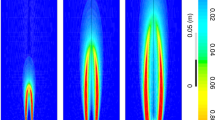Abstract
An unsteady shock-induced combustion (SIC) is characterized by the regularly oscillating combustion phenomenon behind the shock wave supported by the blunt projectile flying around the speed of Chapman-Jouguet detonation wave. The SIC is the coupling phenomenon between the hypersonic flow and the chemical kinetics, but the effects of chemical kinetics have been rarely reported. We compared hydrogen-air reaction mechanisms for the shock-induced combustion to demonstrate the importance of considering the reaction mechanisms for such complex flows. Seven hydrogen-air reaction mechanisms were considered, those available publically and used in other researches. As a first step in the comparison of the hydrogen combustion, ignition delay time of hydrogen-oxygen mixtures was compared at various initial conditions. Laminar premixed flame speed was also compared with available experimental data and at high pressure conditions. In addition, half-reaction length of ZND (Zeldovich-Neumann-Döring) detonation structure accounts for the length scale in SIC phenomena. Oscillation frequency of the SIC is compared by running the time-accurate 3rd-order Navier-Stokes CFD code fully coupled with the detailed chemistry by using four levels of grid resolutions.
Similar content being viewed by others
References
S. Yungster, S. Eberhardt and A.P. Bruckner, Numerical simulation of hypervelocity projectiles in detonable gases, AIAA Journal, 29 (2) (1991) 187–199.
G. J. Wilson and M. A. Sussman, Computation of unsteady shock-induced combustion using logarithmic species conservation equations, AIAA Journal, 31 (2) (1993), 294–301.
S. Yungster and K. Radhakrishnan, Fully implicit timeaccurate method for hypersonic combustion- application to shock-induced combustion instability, Shock Waves, 5 (5) (1996) 293–303.
J.-Y. Choi, I.-S. Jeung and S. Lee, Dimensional analysis of the effect of flow conditions on shock-induced combustion, The Combustion Institute (1996) 2925–2935.
J.-Y. Choi, I.-S. Jeung and Y. Yoon, Numerical investigation of ram accelerator flow field in expansion tube, Springer-Verlag (1998) 242–254.
J-Y. Choi, I.-S. Jeung and Y. Yoon, Scaling effect of the combustion induced by shock-wave boundary-layer interaction in premixed gas, The Combustion Institute (1998) 2181–2188.
J.-Y. Choi, I.-S. Jeung and Y. Yoon, Computational fluid dynamics algorithms for unsteady shock-induced combustion, Part 1: Validation, AIAA Journal, 38 (7) (2000) 1179–1187.
J.-Y. Choi, I.-S. Jeung and Y. Yoon, Computational fluid dynamics algorithms for unsteady shock-induced combustion, Part 2: Comparison, AIAA Journal, 38 (7) (2000) 1188–1195.
J.-Y. Choi, B.-J. Lee and I.-S. Jeung, Computational modeling of high pressure combustion mechanism in scram accelerator, J.Phys. IV France, 10 (11) (2000) 131- 141.
G.-W. Moon, I.-S. Jeung, J-Y. Choi, Y. Yoon, F. Seiler, G. Patz, G. Smeets and J. Srulijes, Numerical modelling and simulation of RAMAC 30 experiment carried out at the French-German research institute of Saint- Louis, J.Phys.IV France, 10 (11) (2000) 143–153.
S.-L. Kim, J.-Y. Choi, I.-S. Jeung, and Y.-H. Park, Application of approximate chemical Jacobians for constant volume reaction and shock-induced combustion, Applied Numerical Mathematics, 39 (2001) 87–104.
H. F. Lehr, Experiments on shock-induced combustion, Astronautica Acta, 17 (1972) 589–597.
B. D. Taylor, D. A. Kessler, V. N. Gamezo and E. S. Oran, Numerical simulations of hydrogen detonations with detailed chemical kinetics, Proceedings of the combustion Institute, 34 (2013) 2009–2016.
C. J. Jachimowski, An analysis of combustion studies in shock expansion tunnels and reflected shock tunnels, NASA — TP 3224, July (1992).
G. J. Wilson and R. W. MacCormack, Modeling supersonic combustion using a fully implicit numerical method, AIAA Journal, 30 (4) (1992) 1008–1015.
C. J. Jachimowski, An analytical study of the hydrogen-air reaction mechanism with application to scramjet combustion, NASA — TP 2791, Feb. (1988).
M. P. Burke, M. Chaos, Y. Ju, F. L. Dryer and S. J. Klippenstein, Comprehensive H2/O2 kinetic model for highpressure combustion, Wiley Online Library, 6 December (2011).
U. Maas and J. Warnatz, Ignition processes in hydrogenoxygen mixtures, Comb. & Flame, 74 (1988) 53–69.
S. G. Davis, A. V. Joshi, H. Wang and F. Egolfopoulos, An optimized kinetic model of H2/CO combustion, Proceedings of the Combustion Institute, 30 (2005) 1283–1292.
CHEMKIN-PRO 15131, Reaction Design, San Diego (2013})
Author information
Authors and Affiliations
Corresponding author
Additional information
This paper was presented at the AJCPP-2014, Jeju Grand Hotel, Jeju, Korea, March 5–8, 2014. Recommended by Guest Editor Heuy Dong Kim
P. Pradeep Kumar is a Master’s student in the Rocket Propulsion Laboratory, Pusan National University, Republic of Korea. He received his B.E. degree in Aeronautical Engineering from Kumaraguru College of Technology (India). His research interests include high speed combustion, multiphase reactive flows simulation, turbulence combustion and combustion instabilities in rocket engines.
Jeong-Yeol Choi is a Professor of Aerospace Engineering, Pusan National University, Republic of Korea. Currently, he is the Program Manager of Space R&D, National Research Foundation of Korea. He received his Ph.D. from the Seoul National University in 1997. His research interests include High Pressure Combustion, Detonation Combustion, Dynamics of Energetics flows, Reaction Kinetics, Multi-Phase/Particle flows, Turbulence-Chemistry interaction in Chemical Propulsion systems.
Rights and permissions
About this article
Cite this article
Kumar, P.P., Kim, KS., Oh, S. et al. Numerical comparison of hydrogen-air reaction mechanisms for unsteady shock-induced combustion applications. J Mech Sci Technol 29, 893–898 (2015). https://doi.org/10.1007/s12206-015-0202-2
Received:
Revised:
Accepted:
Published:
Issue Date:
DOI: https://doi.org/10.1007/s12206-015-0202-2



